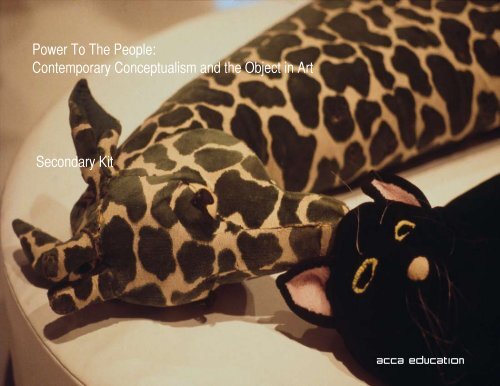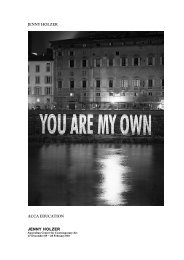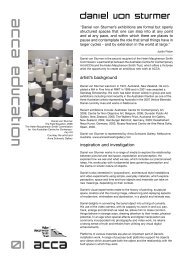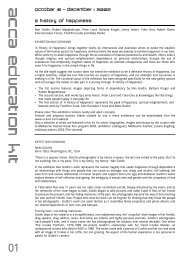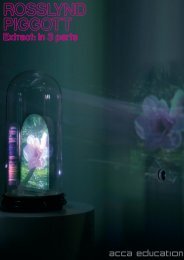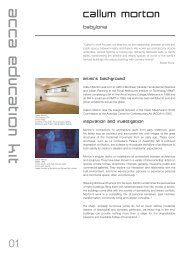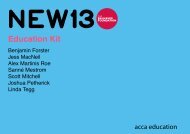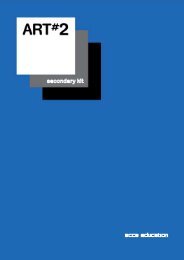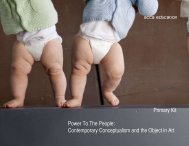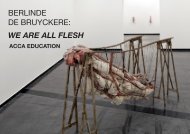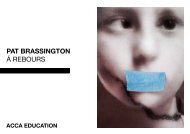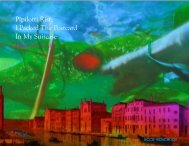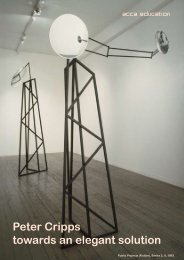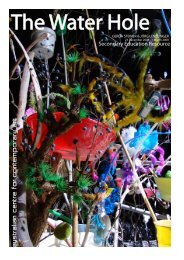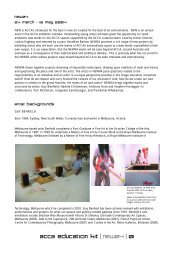Power To The People: Contemporary Conceptualism and ... - ACCA
Power To The People: Contemporary Conceptualism and ... - ACCA
Power To The People: Contemporary Conceptualism and ... - ACCA
Create successful ePaper yourself
Turn your PDF publications into a flip-book with our unique Google optimized e-Paper software.
<strong>Power</strong> <strong>To</strong> <strong>The</strong> <strong>People</strong>:<br />
<strong>Contemporary</strong> <strong>Conceptualism</strong> <strong>and</strong> the Object in Art<br />
Secondary Kit<br />
acca education
!"#$%&#'$()#$%'&*$(+)<br />
!<br />
,-./0)1-)12/),/-,3/!"#$%&!'()*%+",#-!./"!#&!0"&!&"#/"0)1!+(0)"!#)2!%3+-(/%&!"4%!05+(/"#)*%!#)2!0)6-,%)*%!(6!"40&!<br />
+0()%%/0)1!5(7%5%)"!()!#!/%*%)"!1%)%/#"0()!(6!.,&"/#-0#)!#)2!0)"%/)#"0()#-!#/"0&"&8!!<br />
!<br />
94%!%340:0"0()!;,%/0%&!"4%!()1(0)1!/%",/)!(6!*()"%5+(/#/
Conceptual art<br />
<strong>The</strong>n:<br />
During the late 1960s, following events such as <strong>The</strong> Vietnam War, the emergence of the civil rights movement, the strikes of Paris ’68, a new artistic movement,<br />
focused on political <strong>and</strong> social activism began to emerge. Artists began to move away from creating precious, discrete art objects to instigating dynamic<br />
situations, installations, happenings <strong>and</strong> interactive audience projects. <strong>The</strong> art of the first wave of conceptual artists was critical, provocative <strong>and</strong> diverse <strong>and</strong><br />
above all, was founded in its idea rather than its form. As Italian critic <strong>To</strong>masso Trini recognised, the pioneering art created between the sixties <strong>and</strong> seventies<br />
was characterized by “the transfer of interest from the object to the subject, from the things to human beings”.<br />
Now:<br />
<strong>To</strong>day, the strategies of Conceptual Art find themselves reconsidered <strong>and</strong> their relevance exp<strong>and</strong>ed by contemporary artists in light of a number of factors.<br />
<strong>The</strong>se factors include a recent move away from the seemingly never-ending inflated art market <strong>and</strong> the fetishised art object; an increased consciousness of<br />
environmental sustainability <strong>and</strong> a need for material rationalism; a resurgence of performative modes of practice; the continued interrogation of the gallery<br />
as site <strong>and</strong> authority; <strong>and</strong> a desire for an empirical connection to a world that faces an unstable future. <strong>The</strong> original concerns of the conceptualists <strong>and</strong> their<br />
methodologies for finding new ground, continue to be embraced as a means of awareness within a contemporary l<strong>and</strong>scape of new <strong>and</strong> familiar concerns.<br />
Via a range of motivations, methodologies <strong>and</strong> outcomes, the recent generation of artists selected to participate in this exhibition reflect on the strategies of<br />
Conceptual Art in a way that argues their validity today.<br />
acca education
Key themes<br />
Audience<br />
<strong>Power</strong> to the people:<br />
<strong>The</strong> pioneers of Conceptual Art sought to alter the relationship between object <strong>and</strong> audience by freeing the ‘work’ of its physical media <strong>and</strong> locating it in ideas<br />
<strong>and</strong> information freely accessible <strong>and</strong> independent of the gallery system. Through these efforts many artists sought to implicate the audience in their work <strong>and</strong><br />
yet simultaneously relegated them to a secondary role to the art itself. <strong>The</strong> work of those contemporary artists drawing from the first wave of Conceptual Art<br />
proposes a very different relationship with the audience, dem<strong>and</strong>ing a more active <strong>and</strong> responsive relationship <strong>and</strong>, in some cases, even encouraging the audience<br />
to determine the outcome of the work itself.<br />
Imagination<br />
<strong>Power</strong> to the imagination:<br />
Italian write Luca Cerazzi says it best when he argues that, “Conceptual Art told us that what matters is the creative instant, the poesies, or considerations<br />
about it. But poesies - the unconscious moment – is something that is hard to communicate. It can only be provoked or evoked, preferably with dense, synthetic<br />
means. So, conceptual art asserts, it is better to move the object, the image, away from our senses <strong>and</strong> do no more than allude to it. Once it is distanced from<br />
the object <strong>and</strong> image, the art takes place in the ‘beyond’, which is a purely mental place that can be reached by each of us according to our own personal ways<br />
<strong>and</strong> means. It travels a potentially infinite chain of transmission <strong>and</strong> transformations, with the emphasis on what ‘metaphorically’ happens outside the frame in<br />
a sort of delocalization within the walls of our brains.”<br />
Hence, it can be argued that it was Conceptual Art that introduced the idea that it is within the infinitely elastic space of our imagination that an artwork completes<br />
itself or takes shape. Robert Barry reinforced such claims, famously stating that “art is brought to life only in the observer’s imaginative space, in that<br />
subjective place that is our mind.” Forty years later, in an age in which we are all increasingly actors <strong>and</strong> supernumeraries in a huge public performance, there<br />
are still some artists who suggest the possibility of an art that exists in the last remaining private place: our heads. <strong>The</strong> artists participating in this exhibition,<br />
through an economic use of materials, deliberately leave room for the audience’s imagination to translate, transform, distil <strong>and</strong> contribute to the exhibited<br />
work.<br />
acca education
Peter Friedl<br />
Berlin based artist Peter Friedl (b. 1960) explores political awareness, power <strong>and</strong> autonomy, displacement <strong>and</strong> the reinvention of genres through consistently<br />
diverse mediums, styles <strong>and</strong> meanings. Peter Friedl (1998) is a series of animal costumes distributed around the space that the audience can wear <strong>and</strong> inhabit<br />
as they move through the exhibition <strong>and</strong> negotiate other works in the show. <strong>The</strong> work was originally created for an exhibition at the Palais des Beaux-Arts in<br />
Brussels, where Friedl asked the staff to name the animal they would like to be <strong>and</strong> fabricated a heap of childlike costumes from their suggestions. <strong>The</strong> audience<br />
too, chooses a costume to represent themselves, <strong>and</strong> upon wearing it, takes on a new identity. By inhabiting the costume, the viewer becomes the art object,<br />
disrupting the traditional division between the artwork <strong>and</strong> audience.<br />
acca education
Roman Ondák<br />
Roman Ondák (b. 1966) lives <strong>and</strong> works in Bratislava, Slovakia. Ondák creates artistic interventions that blur the boundaries between art <strong>and</strong> reality. Teaching <strong>To</strong><br />
Walk (2002) is a daily happening in which a mother is invited to come to the gallery space <strong>and</strong> to help her young male child to take his first steps. Ondák captures<br />
a short-lived but essential moment in the life of a human being not by representing it, but by involving the audience in it. Teaching <strong>To</strong> Walk transforms the<br />
traditional stillness of the gallery into a performative space <strong>and</strong> a movement based activity into an art object. <strong>The</strong> artist explores the possibilities of how such a<br />
situation would be perceived or whether visitors would even notice it. Through this the child’s achievement is simultaneously undermined <strong>and</strong> monumentalized<br />
by his presence in the gallery. Ondák provokes the question: at what point does reality become art, or vice versa, <strong>and</strong> how does this happen?<br />
acca education
Dora Garcia<br />
Spanish artist Dora Garcia lives <strong>and</strong> works in Brussels. As a performance, installation <strong>and</strong> video artist, Garcia uses the exhibition space as a platform to investigate<br />
the relationship between the visitor, the artwork <strong>and</strong> place. Instant Narrative (2006-08) comprises of a gallery attendant seated at a desk in the space who writes<br />
a text about the visitors to the exhibition. <strong>The</strong>se observations about the audiences are simultaneously projected as a live feed onto the wall of the gallery. <strong>The</strong><br />
result is a real-time story in which the viewers are the protagonists, sometimes knowingly, sometimes not. Instant Narrative alters the traditional viewing experience.<br />
<strong>The</strong> spectator observes the work, yet the work observes back, commenting on the spectator <strong>and</strong> their reaction. Authorship shifts between the artist to the<br />
writer to the visitor, while Garcia plays with the visitor’s expectations, forcing them to question their role in the work <strong>and</strong> the objectives of the project.<br />
acca education
Agatha Gothe Snape<br />
Sydney artist Agatha Gothe-Snape (b. 1980) creates works in mediums as diverse as conversation, performance, participation, painting, printing <strong>and</strong> powerpoint<br />
presentations. Originally performed as part of her Masters of Visual Art, Every Artist Remembered (2009 - ongoing) is a weekly performance held each Friday<br />
evening throughout the exhibition. Gothe-Snape invites another artist (of differing practices <strong>and</strong> generations) to engage in a two hour conversation where they<br />
devise a schemata of art history through the mind mapping/flow charting of artist names directly onto the gallery wall. Each diagrammatic wall drawing traces<br />
the influence of conceptual art through a verbal exchange between the artist <strong>and</strong> invited guests, while also bringing both the Australian <strong>and</strong> female perspectives<br />
into a more central position within the history of Conceptual Art. <strong>The</strong>se performances are open to the public to watch, but not contribute to.<br />
acca education
Natasha Johns-Messenger<br />
Melbourne artist Natasha Johns-Messenger (b. 1974) currently lives <strong>and</strong> works in New York, where she is studying a Masters of Fine Art Film at Columbia University.<br />
Johns-Messenger is best known for her spatial <strong>and</strong> experiential installations that draw on aspects of specific sites. Yellow (2003/2011) is a built corridor<br />
bathed in yellow light that uses strategically located mirrors to extend the perceived limitations of the <strong>ACCA</strong> building both within <strong>and</strong> outside its walls. As they<br />
move through the corridor, the viewer comes across an end point where the image of Vault, an iconic sculpture by Ron Robertson Swann currently located on<br />
<strong>ACCA</strong>’s grounds is made viewable inside the gallery by way of security camera footage projected at window scale. <strong>The</strong> work plays with site, inter-subjectivity, the<br />
material <strong>and</strong> immaterial. <strong>The</strong> work was originally presented in 2003 at the VCA Margaret Lawrence gallery located on the opposite side of the Vault <strong>and</strong> takes<br />
the object perspective to a whole new conceptual plane as it factors in not only a temporal play (the years), but adds the element of the relationship between an<br />
original <strong>and</strong> the re-production.<br />
acca education
Kirsten Pieroth<br />
Kirsten Pieroth (b. 1970) lives <strong>and</strong> works in Berlin <strong>and</strong> examines the overlapping of the real <strong>and</strong> the imaginary, authenticity <strong>and</strong> fakery in her practice. Letter of<br />
an Inventor (2003) explores invention <strong>and</strong> the myths around Thomas Edison. Pieroth purchased a letter signed by inventor Thomas Edison containing the following<br />
sentence “I regret that a previous engagement prevents me from accepting your kind invitation to dinner at your home.” Intrigued as to whether the excuse<br />
was true or merely an invention, the artist set out on an investigation. She wrote to various experts, including the scholar in charge of Edisons papers <strong>and</strong> a great<br />
gr<strong>and</strong>son of the inventor, who concurred an invention was likely. Pieroth then unsuccessfully approached the Patent Office in an attempt to patent it. <strong>The</strong> letters<br />
she sent out <strong>and</strong> the replies received are displayed together, alongside small details of personal ephemera, signed photographs of him asleep on his workbench<br />
<strong>and</strong> a recreation of the table. Edison famously slept only four hours a day <strong>and</strong> used every opportunity to make up for lost time. <strong>The</strong> signature on the photograph<br />
has been copied straight onto the workbench <strong>and</strong> the ‘original’ signature is now a fake. Pieroth weaves a complex study of invention, creating discrepancies<br />
where truth <strong>and</strong> fakery are jumbled together to form an authorized version.<br />
acca education
Matthew Shannon<br />
Melbourne based artist Matthew Shannon (b.1980) investigates translation, technology <strong>and</strong> the experience of viewing art. He is concerned with how objects exist<br />
in a world of images. God And <strong>The</strong> Worm is a digital animation about the Willem de Kooning bronze sculpture, St<strong>and</strong>ing Figure 1969/84, that exists in the garden<br />
to the rear of the National Gallery of Victoria. <strong>The</strong> enormous bronze has been cloned in a computer generated space, with its lumpy mud like body having been<br />
sculpted in a virtual world. <strong>The</strong> movements of the camera show us the sculpture from the extreme points of view, known to cinematographers as the god’s eye<br />
view – looking vertically down on the world – <strong>and</strong> the worm’s eye view – looking vertically up. In between these two extreme points the surface of the sculpture<br />
is examined in great detail, as if the machine is doing the looking for you. <strong>The</strong> work allows us to see the sculpture amplified, for it to be more real in its image<br />
than its physicality. <strong>The</strong> significance of the de Kooning work is in its proximity to <strong>ACCA</strong> where the film will be shown. Viewers of the <strong>ACCA</strong> show will be able to see<br />
both the actual sculpture <strong>and</strong> its virtual counterpart in the same day: they will be able to view the sculpture at the NGV with the human eye as well as the inhuman<br />
eye of the film shown at <strong>ACCA</strong>.<br />
acca education
Curriculum Links<br />
VCE Art Unit 4 Outcome 1 Art Issues<br />
Some artists work “relationally,” meaning, that their work involves interaction with others. Who should be recognized as the creator when artists, performers<br />
<strong>and</strong> audience contribute to the creation of artworks? How valuable is the personal idea to the authorship of artworks? Discuss Roman Ondák’s Teaching <strong>To</strong> Walk<br />
<strong>and</strong> Dora Garcia’s Instant Narrative.<br />
VCE Studio Arts Unit 4 Outcome 3 Arts Industry Contexts<br />
Discuss <strong>ACCA</strong>’s unique curatorial program with specific reference to the <strong>Power</strong> <strong>To</strong> <strong>The</strong> <strong>People</strong> exhibition. What are the key themes <strong>and</strong> curatorial rationale for<br />
the exhibition? How has the audience <strong>and</strong> their participation been considered in the exhibition design? What are some of the challenges of curating a show<br />
involving conceptual art, performances <strong>and</strong> audience interaction, especially with international artists not present for the install?<br />
VCE Philosophy Unit 2 Area of study 2 Outcome 2 Aesthetics VELS LEVEL 6<br />
Discuss Kirsten Pieroth’s Letter Of An Inventor. Does this work appeal more to the imagination than it does aesthetically? What defines the aesthetic? Is beauty<br />
necessary or even desirable in art? Pieroth uses Edison’s original letter, a photograph of his workbench <strong>and</strong> a copy of his workbench <strong>and</strong> signature. How important<br />
is originality in the arts, <strong>and</strong> should we condemn forgeries, or even copies?<br />
VELS LEVEL 5 <strong>and</strong> 6 ACTIVITIES AND DISCUSSION TOPICS<br />
Research Joseph Beuys <strong>and</strong> Social Sculpture.<br />
Create a conceptual art piece based on bringing real life into the gallery setting. Write a list of instructions. Who would perform, yourself or, would you involve<br />
the audience?<br />
Do you think it’s possible to own a piece of performance art?<br />
acca


